Exploring Hierarchy and Power Relations in Australian Healthcare
VerifiedAdded on 2023/06/13
|10
|2910
|177
Essay
AI Summary
This essay provides a comprehensive analysis of the Australian healthcare system, focusing on the intrinsic hierarchy and power dynamics that shape its operations. It examines the background of the healthcare system through sociological theories, particularly focusing on ward rounds as key decision-making sites and the impact of spatial practices on professional power. The essay critically assesses medication communication, highlighting power relations among nurses, doctors, and patients, and employs critical ethnography to unveil the stratification within the system. Drawing on Foucault's concept of power, the analysis illustrates how power is embedded in everyday interactions and institutional structures, particularly through the authoritative position of doctors and the marginalization of nurses. The study underscores the importance of understanding these power dynamics to improve healthcare practices and promote more equitable relationships within the healthcare environment. The essay concludes by reflecting on the implications of these power structures for healthcare practitioners.
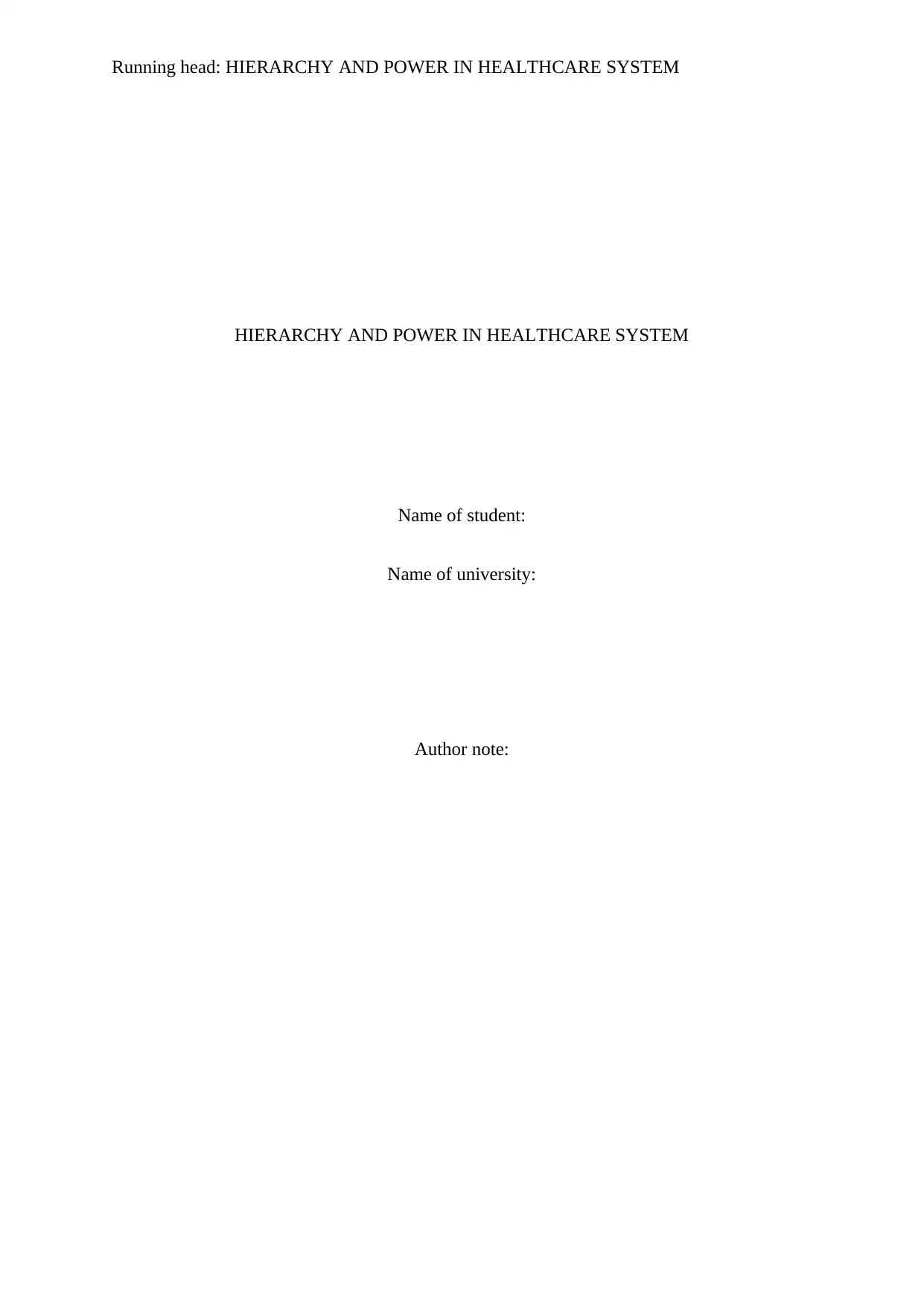
Running head: HIERARCHY AND POWER IN HEALTHCARE SYSTEM
HIERARCHY AND POWER IN HEALTHCARE SYSTEM
Name of student:
Name of university:
Author note:
HIERARCHY AND POWER IN HEALTHCARE SYSTEM
Name of student:
Name of university:
Author note:
Paraphrase This Document
Need a fresh take? Get an instant paraphrase of this document with our AI Paraphraser
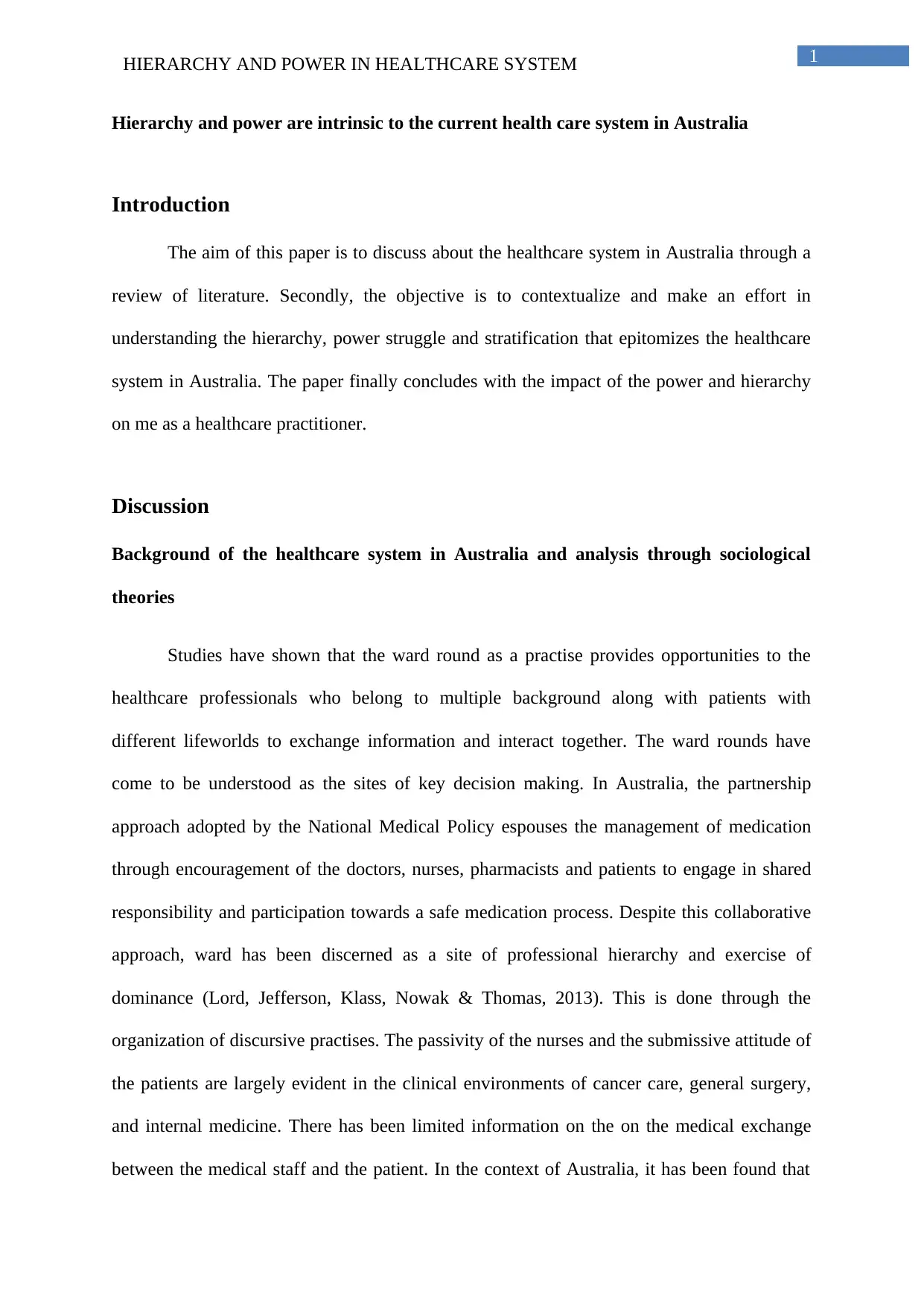
1HIERARCHY AND POWER IN HEALTHCARE SYSTEM
Hierarchy and power are intrinsic to the current health care system in Australia
Introduction
The aim of this paper is to discuss about the healthcare system in Australia through a
review of literature. Secondly, the objective is to contextualize and make an effort in
understanding the hierarchy, power struggle and stratification that epitomizes the healthcare
system in Australia. The paper finally concludes with the impact of the power and hierarchy
on me as a healthcare practitioner.
Discussion
Background of the healthcare system in Australia and analysis through sociological
theories
Studies have shown that the ward round as a practise provides opportunities to the
healthcare professionals who belong to multiple background along with patients with
different lifeworlds to exchange information and interact together. The ward rounds have
come to be understood as the sites of key decision making. In Australia, the partnership
approach adopted by the National Medical Policy espouses the management of medication
through encouragement of the doctors, nurses, pharmacists and patients to engage in shared
responsibility and participation towards a safe medication process. Despite this collaborative
approach, ward has been discerned as a site of professional hierarchy and exercise of
dominance (Lord, Jefferson, Klass, Nowak & Thomas, 2013). This is done through the
organization of discursive practises. The passivity of the nurses and the submissive attitude of
the patients are largely evident in the clinical environments of cancer care, general surgery,
and internal medicine. There has been limited information on the on the medical exchange
between the medical staff and the patient. In the context of Australia, it has been found that
Hierarchy and power are intrinsic to the current health care system in Australia
Introduction
The aim of this paper is to discuss about the healthcare system in Australia through a
review of literature. Secondly, the objective is to contextualize and make an effort in
understanding the hierarchy, power struggle and stratification that epitomizes the healthcare
system in Australia. The paper finally concludes with the impact of the power and hierarchy
on me as a healthcare practitioner.
Discussion
Background of the healthcare system in Australia and analysis through sociological
theories
Studies have shown that the ward round as a practise provides opportunities to the
healthcare professionals who belong to multiple background along with patients with
different lifeworlds to exchange information and interact together. The ward rounds have
come to be understood as the sites of key decision making. In Australia, the partnership
approach adopted by the National Medical Policy espouses the management of medication
through encouragement of the doctors, nurses, pharmacists and patients to engage in shared
responsibility and participation towards a safe medication process. Despite this collaborative
approach, ward has been discerned as a site of professional hierarchy and exercise of
dominance (Lord, Jefferson, Klass, Nowak & Thomas, 2013). This is done through the
organization of discursive practises. The passivity of the nurses and the submissive attitude of
the patients are largely evident in the clinical environments of cancer care, general surgery,
and internal medicine. There has been limited information on the on the medical exchange
between the medical staff and the patient. In the context of Australia, it has been found that

2HIERARCHY AND POWER IN HEALTHCARE SYSTEM
doctors make clinical decisions in the confines of a private room before deciding to move
towards the patients who is in a critical care environment. On the contrary, nurses are found
to be making decisions in the open-floor of the hospital. This spatial distance between
making decisions in the confines of the private room and that of the open-floor curtails the
power of the power of the nurses in making clinical decisions. Scholars have termed the
patients of the hospitals as audience of front-stage shows. The issue of power dynamics can
be further witnessed in the bodily dispositions of the doctors before their round of the ward
duty and after their round of the ward duty. There have been vast amount of studies in the
field of spatial differences in the Australian healthcare system but the scholars have identified
lacunae in literature. It has been found that there has not been substantial studies that
encapsulates the interactions between the patients and families along with the healthcare
professionals who belong to different disciplines. Another aspect that not been explored is the
nature and dynamics of medication interactions that are organized in the spatial context of the
ward rounds. Liu, Manias and Gerdtz (2012), in their study of Medication communication
during ward rounds on medical wards: Power relations and spatial practices provide a
prolific account of power relations that are enmeshed in the everyday interaction and
practises of ward duties. Medication communication can be defined as interaction pertaining
to the treatment regimen among the nurses, doctors, family members of the patients,
pharmacists and various other stakeholders of the medical profession. The manner in which
the information on medication is communicated and the ways in which the information is
disseminated is imbued in power relationships (Johnson, 2016). A critical social theory
approach on this issue is imperative as it debunks the dominant worldview and delves deeper
into the power relationships that define, structure and inform the everyday clinical
interactions. Therefore, the social theory approach becomes a tool and a lens for
understanding the political struggles and power relations existing among the various
doctors make clinical decisions in the confines of a private room before deciding to move
towards the patients who is in a critical care environment. On the contrary, nurses are found
to be making decisions in the open-floor of the hospital. This spatial distance between
making decisions in the confines of the private room and that of the open-floor curtails the
power of the power of the nurses in making clinical decisions. Scholars have termed the
patients of the hospitals as audience of front-stage shows. The issue of power dynamics can
be further witnessed in the bodily dispositions of the doctors before their round of the ward
duty and after their round of the ward duty. There have been vast amount of studies in the
field of spatial differences in the Australian healthcare system but the scholars have identified
lacunae in literature. It has been found that there has not been substantial studies that
encapsulates the interactions between the patients and families along with the healthcare
professionals who belong to different disciplines. Another aspect that not been explored is the
nature and dynamics of medication interactions that are organized in the spatial context of the
ward rounds. Liu, Manias and Gerdtz (2012), in their study of Medication communication
during ward rounds on medical wards: Power relations and spatial practices provide a
prolific account of power relations that are enmeshed in the everyday interaction and
practises of ward duties. Medication communication can be defined as interaction pertaining
to the treatment regimen among the nurses, doctors, family members of the patients,
pharmacists and various other stakeholders of the medical profession. The manner in which
the information on medication is communicated and the ways in which the information is
disseminated is imbued in power relationships (Johnson, 2016). A critical social theory
approach on this issue is imperative as it debunks the dominant worldview and delves deeper
into the power relationships that define, structure and inform the everyday clinical
interactions. Therefore, the social theory approach becomes a tool and a lens for
understanding the political struggles and power relations existing among the various
⊘ This is a preview!⊘
Do you want full access?
Subscribe today to unlock all pages.

Trusted by 1+ million students worldwide
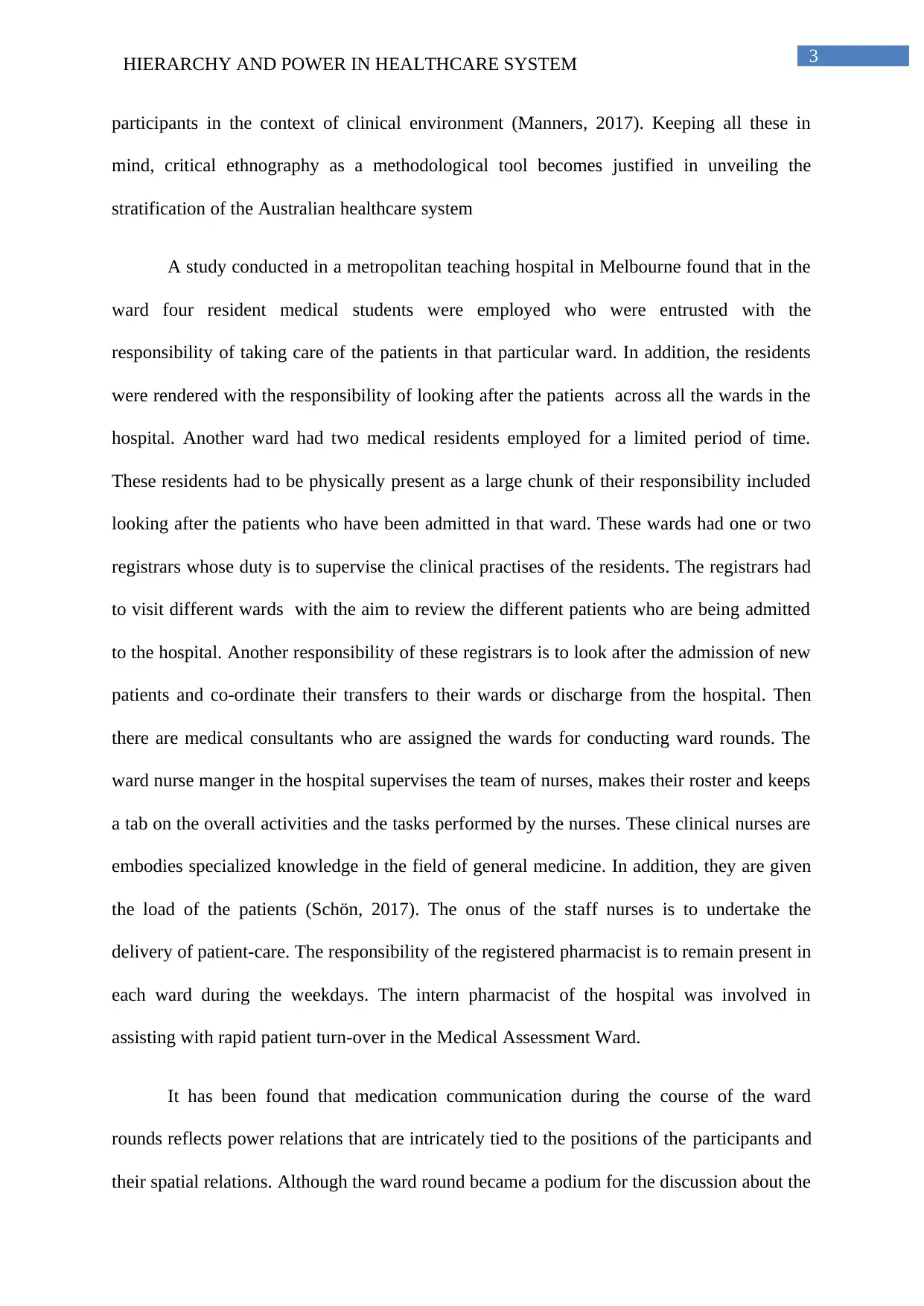
3HIERARCHY AND POWER IN HEALTHCARE SYSTEM
participants in the context of clinical environment (Manners, 2017). Keeping all these in
mind, critical ethnography as a methodological tool becomes justified in unveiling the
stratification of the Australian healthcare system
A study conducted in a metropolitan teaching hospital in Melbourne found that in the
ward four resident medical students were employed who were entrusted with the
responsibility of taking care of the patients in that particular ward. In addition, the residents
were rendered with the responsibility of looking after the patients across all the wards in the
hospital. Another ward had two medical residents employed for a limited period of time.
These residents had to be physically present as a large chunk of their responsibility included
looking after the patients who have been admitted in that ward. These wards had one or two
registrars whose duty is to supervise the clinical practises of the residents. The registrars had
to visit different wards with the aim to review the different patients who are being admitted
to the hospital. Another responsibility of these registrars is to look after the admission of new
patients and co-ordinate their transfers to their wards or discharge from the hospital. Then
there are medical consultants who are assigned the wards for conducting ward rounds. The
ward nurse manger in the hospital supervises the team of nurses, makes their roster and keeps
a tab on the overall activities and the tasks performed by the nurses. These clinical nurses are
embodies specialized knowledge in the field of general medicine. In addition, they are given
the load of the patients (Schön, 2017). The onus of the staff nurses is to undertake the
delivery of patient-care. The responsibility of the registered pharmacist is to remain present in
each ward during the weekdays. The intern pharmacist of the hospital was involved in
assisting with rapid patient turn-over in the Medical Assessment Ward.
It has been found that medication communication during the course of the ward
rounds reflects power relations that are intricately tied to the positions of the participants and
their spatial relations. Although the ward round became a podium for the discussion about the
participants in the context of clinical environment (Manners, 2017). Keeping all these in
mind, critical ethnography as a methodological tool becomes justified in unveiling the
stratification of the Australian healthcare system
A study conducted in a metropolitan teaching hospital in Melbourne found that in the
ward four resident medical students were employed who were entrusted with the
responsibility of taking care of the patients in that particular ward. In addition, the residents
were rendered with the responsibility of looking after the patients across all the wards in the
hospital. Another ward had two medical residents employed for a limited period of time.
These residents had to be physically present as a large chunk of their responsibility included
looking after the patients who have been admitted in that ward. These wards had one or two
registrars whose duty is to supervise the clinical practises of the residents. The registrars had
to visit different wards with the aim to review the different patients who are being admitted
to the hospital. Another responsibility of these registrars is to look after the admission of new
patients and co-ordinate their transfers to their wards or discharge from the hospital. Then
there are medical consultants who are assigned the wards for conducting ward rounds. The
ward nurse manger in the hospital supervises the team of nurses, makes their roster and keeps
a tab on the overall activities and the tasks performed by the nurses. These clinical nurses are
embodies specialized knowledge in the field of general medicine. In addition, they are given
the load of the patients (Schön, 2017). The onus of the staff nurses is to undertake the
delivery of patient-care. The responsibility of the registered pharmacist is to remain present in
each ward during the weekdays. The intern pharmacist of the hospital was involved in
assisting with rapid patient turn-over in the Medical Assessment Ward.
It has been found that medication communication during the course of the ward
rounds reflects power relations that are intricately tied to the positions of the participants and
their spatial relations. Although the ward round became a podium for the discussion about the
Paraphrase This Document
Need a fresh take? Get an instant paraphrase of this document with our AI Paraphraser
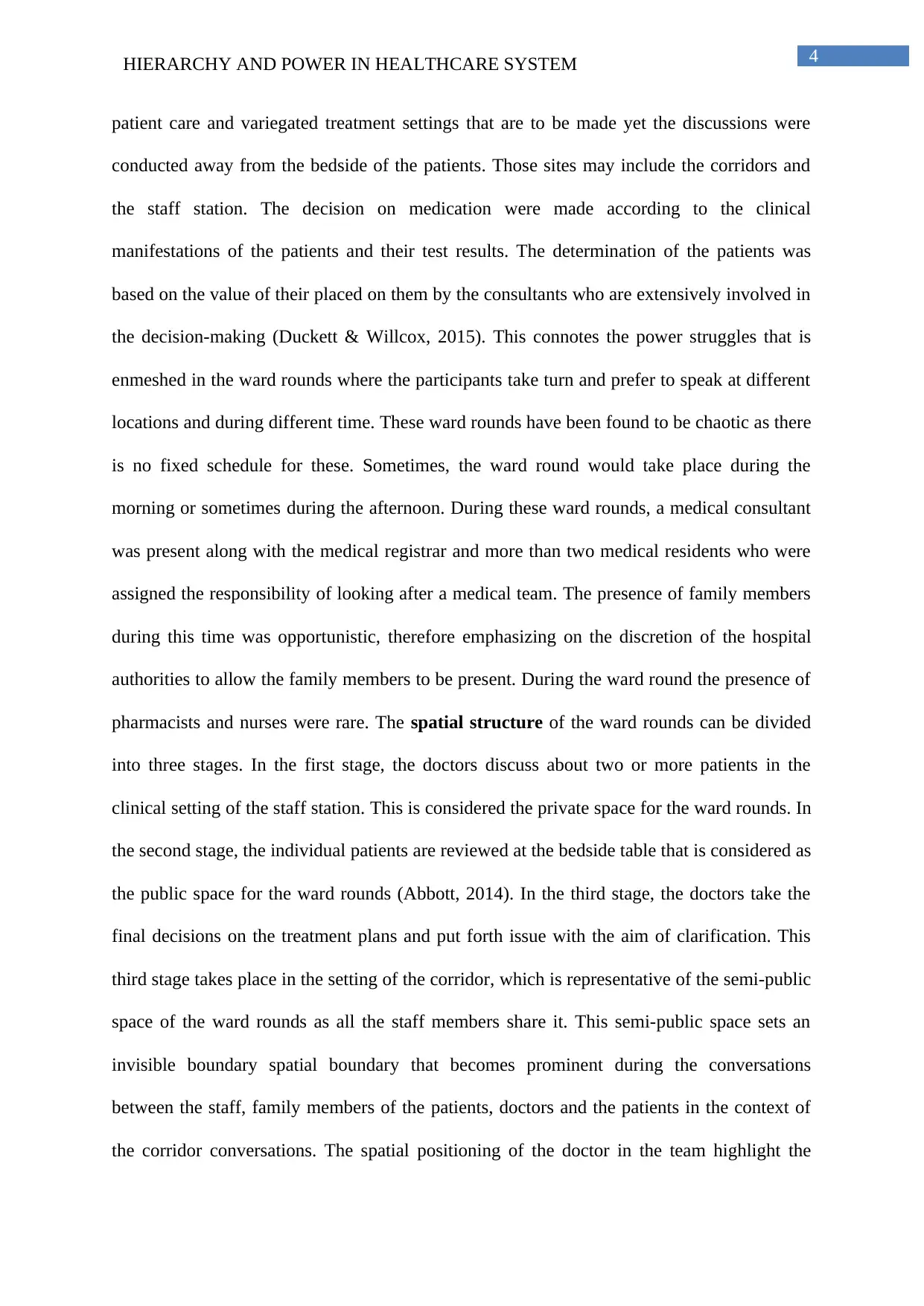
4HIERARCHY AND POWER IN HEALTHCARE SYSTEM
patient care and variegated treatment settings that are to be made yet the discussions were
conducted away from the bedside of the patients. Those sites may include the corridors and
the staff station. The decision on medication were made according to the clinical
manifestations of the patients and their test results. The determination of the patients was
based on the value of their placed on them by the consultants who are extensively involved in
the decision-making (Duckett & Willcox, 2015). This connotes the power struggles that is
enmeshed in the ward rounds where the participants take turn and prefer to speak at different
locations and during different time. These ward rounds have been found to be chaotic as there
is no fixed schedule for these. Sometimes, the ward round would take place during the
morning or sometimes during the afternoon. During these ward rounds, a medical consultant
was present along with the medical registrar and more than two medical residents who were
assigned the responsibility of looking after a medical team. The presence of family members
during this time was opportunistic, therefore emphasizing on the discretion of the hospital
authorities to allow the family members to be present. During the ward round the presence of
pharmacists and nurses were rare. The spatial structure of the ward rounds can be divided
into three stages. In the first stage, the doctors discuss about two or more patients in the
clinical setting of the staff station. This is considered the private space for the ward rounds. In
the second stage, the individual patients are reviewed at the bedside table that is considered as
the public space for the ward rounds (Abbott, 2014). In the third stage, the doctors take the
final decisions on the treatment plans and put forth issue with the aim of clarification. This
third stage takes place in the setting of the corridor, which is representative of the semi-public
space of the ward rounds as all the staff members share it. This semi-public space sets an
invisible boundary spatial boundary that becomes prominent during the conversations
between the staff, family members of the patients, doctors and the patients in the context of
the corridor conversations. The spatial positioning of the doctor in the team highlight the
patient care and variegated treatment settings that are to be made yet the discussions were
conducted away from the bedside of the patients. Those sites may include the corridors and
the staff station. The decision on medication were made according to the clinical
manifestations of the patients and their test results. The determination of the patients was
based on the value of their placed on them by the consultants who are extensively involved in
the decision-making (Duckett & Willcox, 2015). This connotes the power struggles that is
enmeshed in the ward rounds where the participants take turn and prefer to speak at different
locations and during different time. These ward rounds have been found to be chaotic as there
is no fixed schedule for these. Sometimes, the ward round would take place during the
morning or sometimes during the afternoon. During these ward rounds, a medical consultant
was present along with the medical registrar and more than two medical residents who were
assigned the responsibility of looking after a medical team. The presence of family members
during this time was opportunistic, therefore emphasizing on the discretion of the hospital
authorities to allow the family members to be present. During the ward round the presence of
pharmacists and nurses were rare. The spatial structure of the ward rounds can be divided
into three stages. In the first stage, the doctors discuss about two or more patients in the
clinical setting of the staff station. This is considered the private space for the ward rounds. In
the second stage, the individual patients are reviewed at the bedside table that is considered as
the public space for the ward rounds (Abbott, 2014). In the third stage, the doctors take the
final decisions on the treatment plans and put forth issue with the aim of clarification. This
third stage takes place in the setting of the corridor, which is representative of the semi-public
space of the ward rounds as all the staff members share it. This semi-public space sets an
invisible boundary spatial boundary that becomes prominent during the conversations
between the staff, family members of the patients, doctors and the patients in the context of
the corridor conversations. The spatial positioning of the doctor in the team highlight the
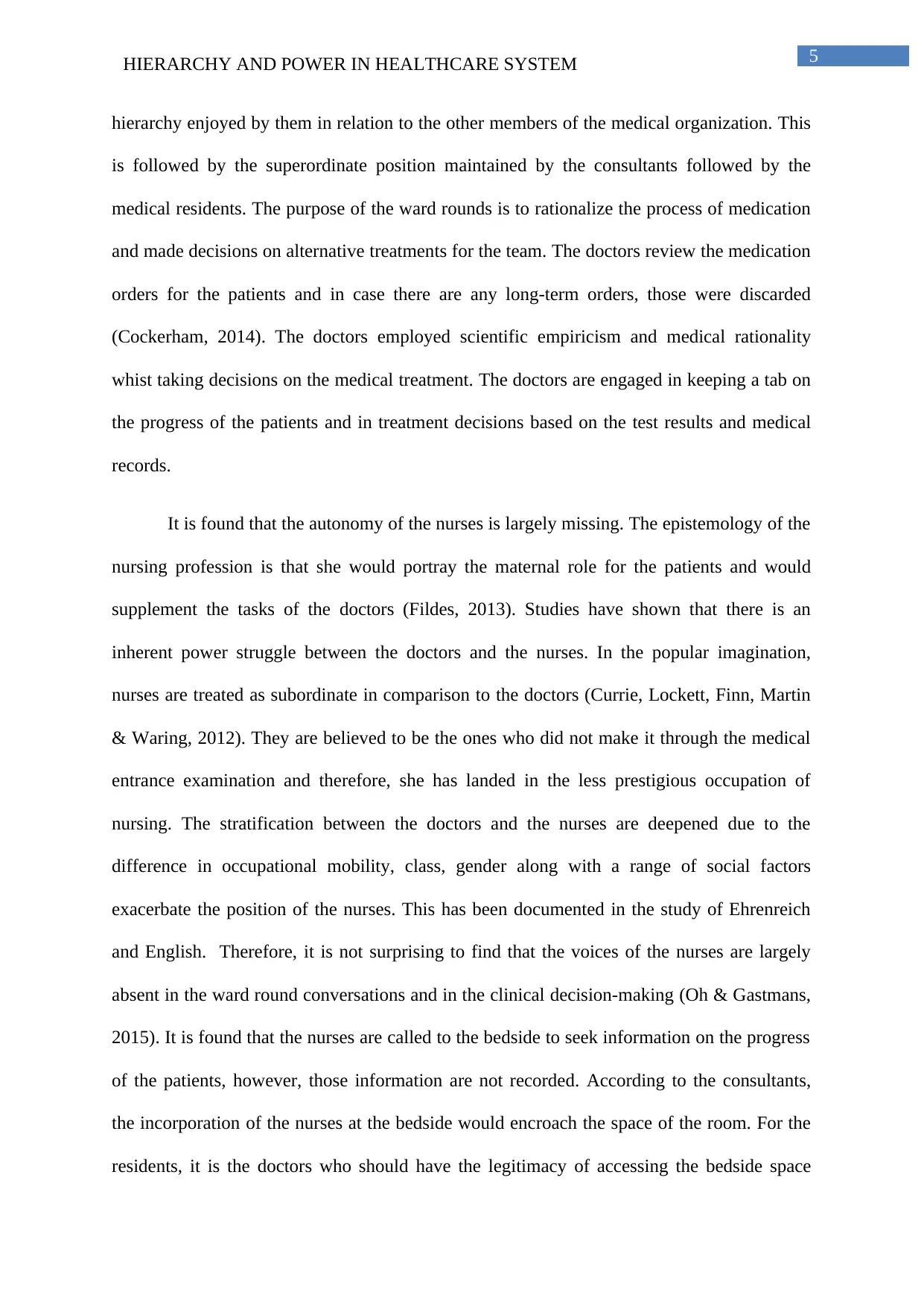
5HIERARCHY AND POWER IN HEALTHCARE SYSTEM
hierarchy enjoyed by them in relation to the other members of the medical organization. This
is followed by the superordinate position maintained by the consultants followed by the
medical residents. The purpose of the ward rounds is to rationalize the process of medication
and made decisions on alternative treatments for the team. The doctors review the medication
orders for the patients and in case there are any long-term orders, those were discarded
(Cockerham, 2014). The doctors employed scientific empiricism and medical rationality
whist taking decisions on the medical treatment. The doctors are engaged in keeping a tab on
the progress of the patients and in treatment decisions based on the test results and medical
records.
It is found that the autonomy of the nurses is largely missing. The epistemology of the
nursing profession is that she would portray the maternal role for the patients and would
supplement the tasks of the doctors (Fildes, 2013). Studies have shown that there is an
inherent power struggle between the doctors and the nurses. In the popular imagination,
nurses are treated as subordinate in comparison to the doctors (Currie, Lockett, Finn, Martin
& Waring, 2012). They are believed to be the ones who did not make it through the medical
entrance examination and therefore, she has landed in the less prestigious occupation of
nursing. The stratification between the doctors and the nurses are deepened due to the
difference in occupational mobility, class, gender along with a range of social factors
exacerbate the position of the nurses. This has been documented in the study of Ehrenreich
and English. Therefore, it is not surprising to find that the voices of the nurses are largely
absent in the ward round conversations and in the clinical decision-making (Oh & Gastmans,
2015). It is found that the nurses are called to the bedside to seek information on the progress
of the patients, however, those information are not recorded. According to the consultants,
the incorporation of the nurses at the bedside would encroach the space of the room. For the
residents, it is the doctors who should have the legitimacy of accessing the bedside space
hierarchy enjoyed by them in relation to the other members of the medical organization. This
is followed by the superordinate position maintained by the consultants followed by the
medical residents. The purpose of the ward rounds is to rationalize the process of medication
and made decisions on alternative treatments for the team. The doctors review the medication
orders for the patients and in case there are any long-term orders, those were discarded
(Cockerham, 2014). The doctors employed scientific empiricism and medical rationality
whist taking decisions on the medical treatment. The doctors are engaged in keeping a tab on
the progress of the patients and in treatment decisions based on the test results and medical
records.
It is found that the autonomy of the nurses is largely missing. The epistemology of the
nursing profession is that she would portray the maternal role for the patients and would
supplement the tasks of the doctors (Fildes, 2013). Studies have shown that there is an
inherent power struggle between the doctors and the nurses. In the popular imagination,
nurses are treated as subordinate in comparison to the doctors (Currie, Lockett, Finn, Martin
& Waring, 2012). They are believed to be the ones who did not make it through the medical
entrance examination and therefore, she has landed in the less prestigious occupation of
nursing. The stratification between the doctors and the nurses are deepened due to the
difference in occupational mobility, class, gender along with a range of social factors
exacerbate the position of the nurses. This has been documented in the study of Ehrenreich
and English. Therefore, it is not surprising to find that the voices of the nurses are largely
absent in the ward round conversations and in the clinical decision-making (Oh & Gastmans,
2015). It is found that the nurses are called to the bedside to seek information on the progress
of the patients, however, those information are not recorded. According to the consultants,
the incorporation of the nurses at the bedside would encroach the space of the room. For the
residents, it is the doctors who should have the legitimacy of accessing the bedside space
⊘ This is a preview!⊘
Do you want full access?
Subscribe today to unlock all pages.

Trusted by 1+ million students worldwide
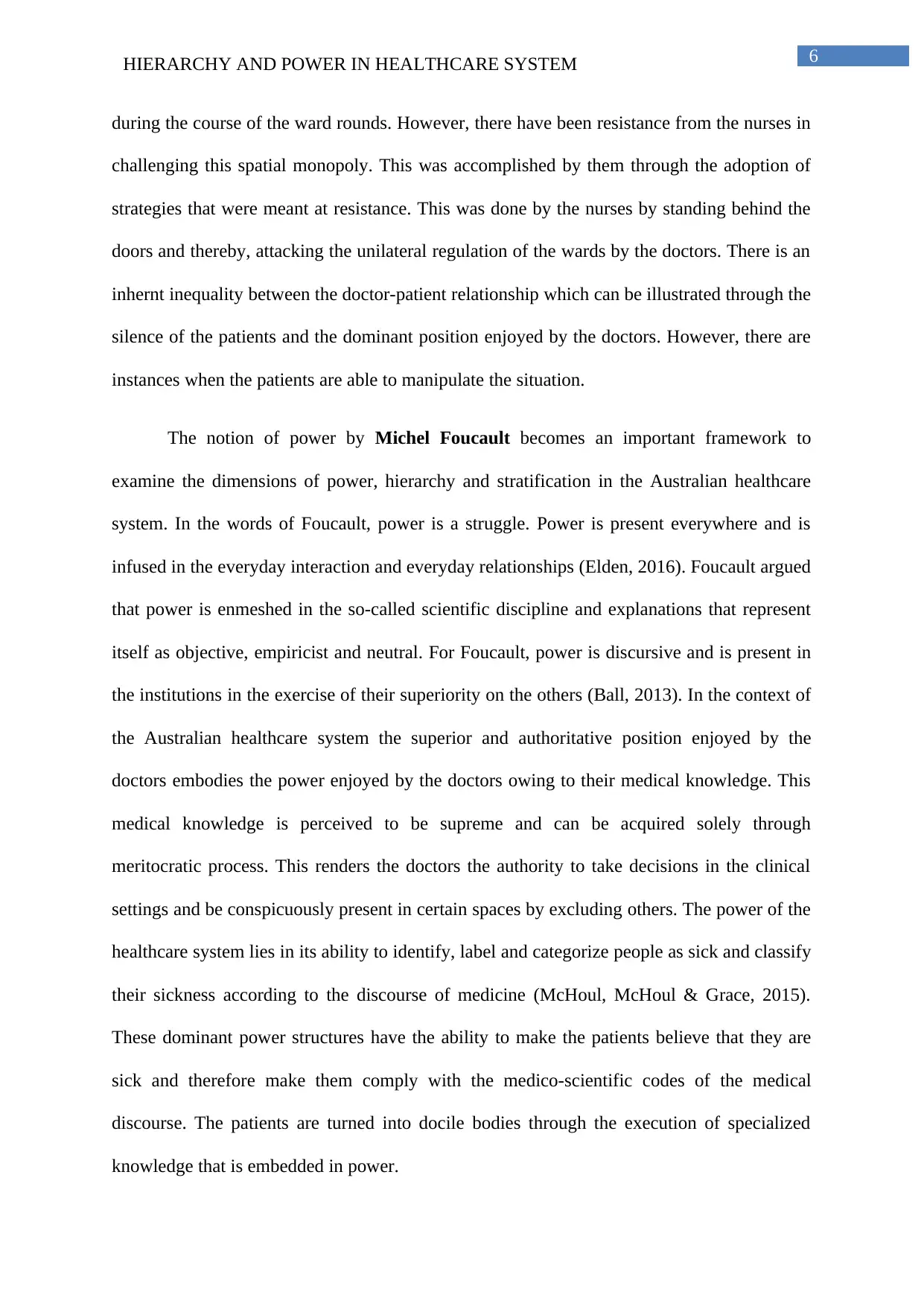
6HIERARCHY AND POWER IN HEALTHCARE SYSTEM
during the course of the ward rounds. However, there have been resistance from the nurses in
challenging this spatial monopoly. This was accomplished by them through the adoption of
strategies that were meant at resistance. This was done by the nurses by standing behind the
doors and thereby, attacking the unilateral regulation of the wards by the doctors. There is an
inhernt inequality between the doctor-patient relationship which can be illustrated through the
silence of the patients and the dominant position enjoyed by the doctors. However, there are
instances when the patients are able to manipulate the situation.
The notion of power by Michel Foucault becomes an important framework to
examine the dimensions of power, hierarchy and stratification in the Australian healthcare
system. In the words of Foucault, power is a struggle. Power is present everywhere and is
infused in the everyday interaction and everyday relationships (Elden, 2016). Foucault argued
that power is enmeshed in the so-called scientific discipline and explanations that represent
itself as objective, empiricist and neutral. For Foucault, power is discursive and is present in
the institutions in the exercise of their superiority on the others (Ball, 2013). In the context of
the Australian healthcare system the superior and authoritative position enjoyed by the
doctors embodies the power enjoyed by the doctors owing to their medical knowledge. This
medical knowledge is perceived to be supreme and can be acquired solely through
meritocratic process. This renders the doctors the authority to take decisions in the clinical
settings and be conspicuously present in certain spaces by excluding others. The power of the
healthcare system lies in its ability to identify, label and categorize people as sick and classify
their sickness according to the discourse of medicine (McHoul, McHoul & Grace, 2015).
These dominant power structures have the ability to make the patients believe that they are
sick and therefore make them comply with the medico-scientific codes of the medical
discourse. The patients are turned into docile bodies through the execution of specialized
knowledge that is embedded in power.
during the course of the ward rounds. However, there have been resistance from the nurses in
challenging this spatial monopoly. This was accomplished by them through the adoption of
strategies that were meant at resistance. This was done by the nurses by standing behind the
doors and thereby, attacking the unilateral regulation of the wards by the doctors. There is an
inhernt inequality between the doctor-patient relationship which can be illustrated through the
silence of the patients and the dominant position enjoyed by the doctors. However, there are
instances when the patients are able to manipulate the situation.
The notion of power by Michel Foucault becomes an important framework to
examine the dimensions of power, hierarchy and stratification in the Australian healthcare
system. In the words of Foucault, power is a struggle. Power is present everywhere and is
infused in the everyday interaction and everyday relationships (Elden, 2016). Foucault argued
that power is enmeshed in the so-called scientific discipline and explanations that represent
itself as objective, empiricist and neutral. For Foucault, power is discursive and is present in
the institutions in the exercise of their superiority on the others (Ball, 2013). In the context of
the Australian healthcare system the superior and authoritative position enjoyed by the
doctors embodies the power enjoyed by the doctors owing to their medical knowledge. This
medical knowledge is perceived to be supreme and can be acquired solely through
meritocratic process. This renders the doctors the authority to take decisions in the clinical
settings and be conspicuously present in certain spaces by excluding others. The power of the
healthcare system lies in its ability to identify, label and categorize people as sick and classify
their sickness according to the discourse of medicine (McHoul, McHoul & Grace, 2015).
These dominant power structures have the ability to make the patients believe that they are
sick and therefore make them comply with the medico-scientific codes of the medical
discourse. The patients are turned into docile bodies through the execution of specialized
knowledge that is embedded in power.
Paraphrase This Document
Need a fresh take? Get an instant paraphrase of this document with our AI Paraphraser
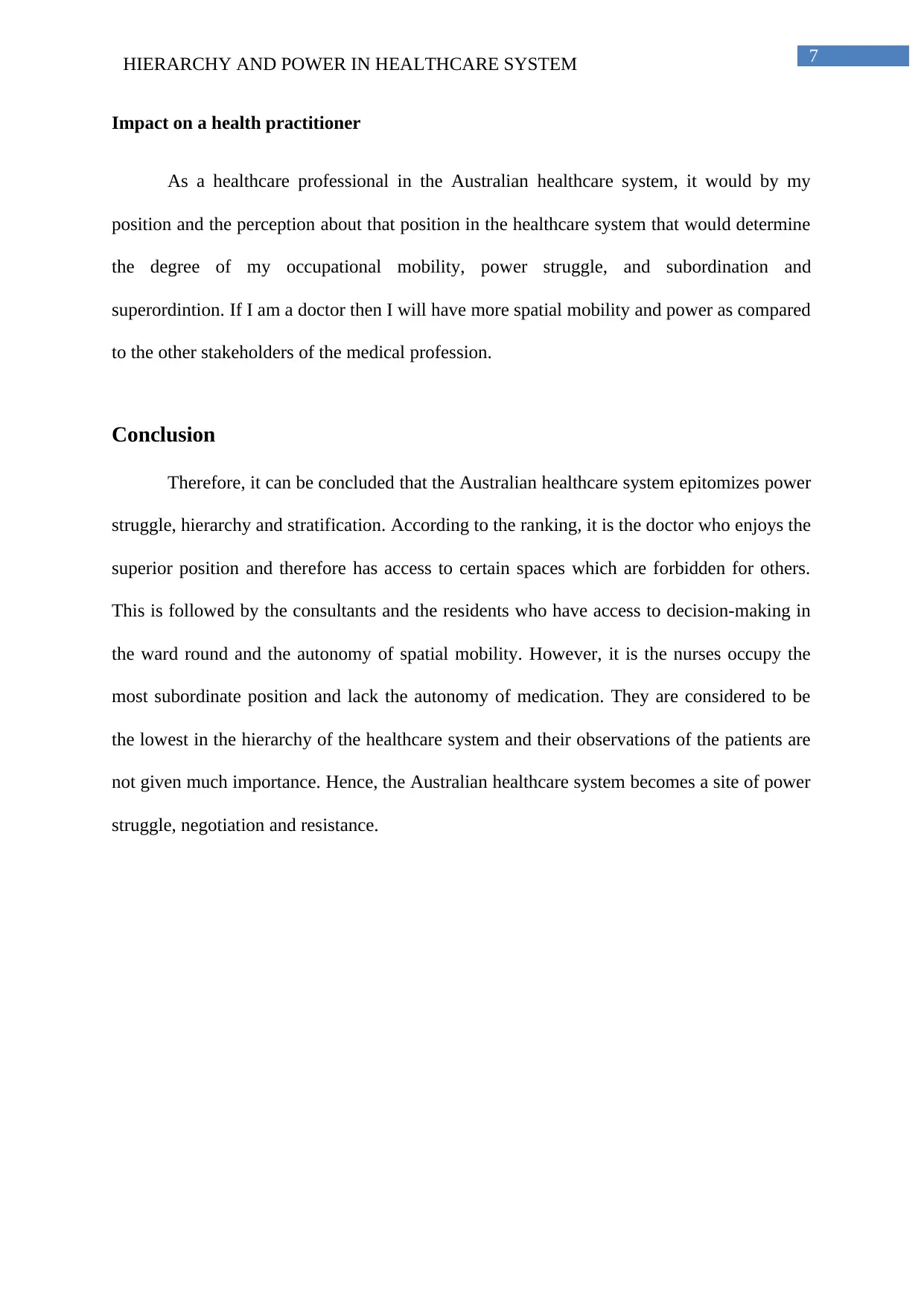
7HIERARCHY AND POWER IN HEALTHCARE SYSTEM
Impact on a health practitioner
As a healthcare professional in the Australian healthcare system, it would by my
position and the perception about that position in the healthcare system that would determine
the degree of my occupational mobility, power struggle, and subordination and
superordintion. If I am a doctor then I will have more spatial mobility and power as compared
to the other stakeholders of the medical profession.
Conclusion
Therefore, it can be concluded that the Australian healthcare system epitomizes power
struggle, hierarchy and stratification. According to the ranking, it is the doctor who enjoys the
superior position and therefore has access to certain spaces which are forbidden for others.
This is followed by the consultants and the residents who have access to decision-making in
the ward round and the autonomy of spatial mobility. However, it is the nurses occupy the
most subordinate position and lack the autonomy of medication. They are considered to be
the lowest in the hierarchy of the healthcare system and their observations of the patients are
not given much importance. Hence, the Australian healthcare system becomes a site of power
struggle, negotiation and resistance.
Impact on a health practitioner
As a healthcare professional in the Australian healthcare system, it would by my
position and the perception about that position in the healthcare system that would determine
the degree of my occupational mobility, power struggle, and subordination and
superordintion. If I am a doctor then I will have more spatial mobility and power as compared
to the other stakeholders of the medical profession.
Conclusion
Therefore, it can be concluded that the Australian healthcare system epitomizes power
struggle, hierarchy and stratification. According to the ranking, it is the doctor who enjoys the
superior position and therefore has access to certain spaces which are forbidden for others.
This is followed by the consultants and the residents who have access to decision-making in
the ward round and the autonomy of spatial mobility. However, it is the nurses occupy the
most subordinate position and lack the autonomy of medication. They are considered to be
the lowest in the hierarchy of the healthcare system and their observations of the patients are
not given much importance. Hence, the Australian healthcare system becomes a site of power
struggle, negotiation and resistance.
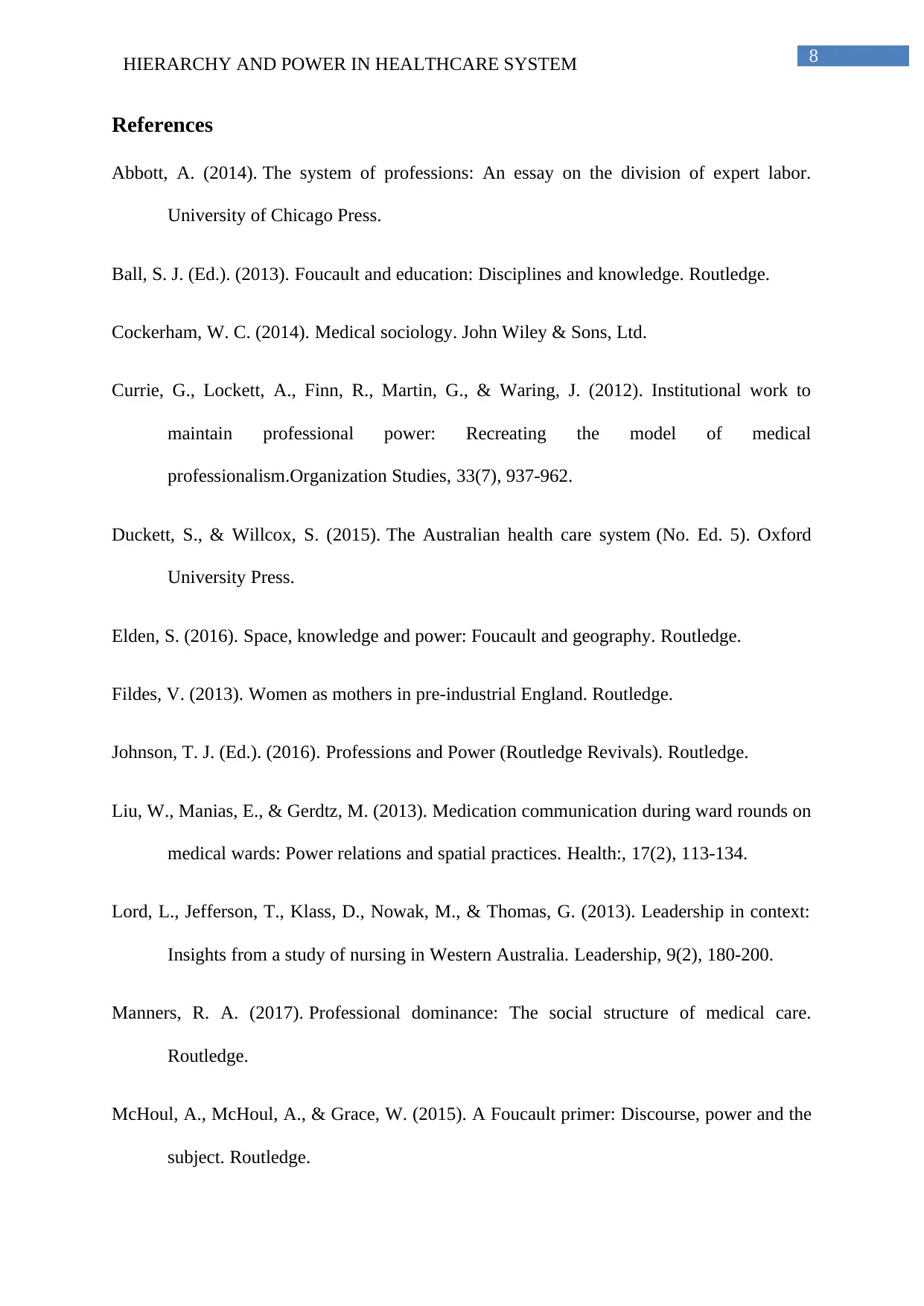
8HIERARCHY AND POWER IN HEALTHCARE SYSTEM
References
Abbott, A. (2014). The system of professions: An essay on the division of expert labor.
University of Chicago Press.
Ball, S. J. (Ed.). (2013). Foucault and education: Disciplines and knowledge. Routledge.
Cockerham, W. C. (2014). Medical sociology. John Wiley & Sons, Ltd.
Currie, G., Lockett, A., Finn, R., Martin, G., & Waring, J. (2012). Institutional work to
maintain professional power: Recreating the model of medical
professionalism.Organization Studies, 33(7), 937-962.
Duckett, S., & Willcox, S. (2015). The Australian health care system (No. Ed. 5). Oxford
University Press.
Elden, S. (2016). Space, knowledge and power: Foucault and geography. Routledge.
Fildes, V. (2013). Women as mothers in pre-industrial England. Routledge.
Johnson, T. J. (Ed.). (2016). Professions and Power (Routledge Revivals). Routledge.
Liu, W., Manias, E., & Gerdtz, M. (2013). Medication communication during ward rounds on
medical wards: Power relations and spatial practices. Health:, 17(2), 113-134.
Lord, L., Jefferson, T., Klass, D., Nowak, M., & Thomas, G. (2013). Leadership in context:
Insights from a study of nursing in Western Australia. Leadership, 9(2), 180-200.
Manners, R. A. (2017). Professional dominance: The social structure of medical care.
Routledge.
McHoul, A., McHoul, A., & Grace, W. (2015). A Foucault primer: Discourse, power and the
subject. Routledge.
References
Abbott, A. (2014). The system of professions: An essay on the division of expert labor.
University of Chicago Press.
Ball, S. J. (Ed.). (2013). Foucault and education: Disciplines and knowledge. Routledge.
Cockerham, W. C. (2014). Medical sociology. John Wiley & Sons, Ltd.
Currie, G., Lockett, A., Finn, R., Martin, G., & Waring, J. (2012). Institutional work to
maintain professional power: Recreating the model of medical
professionalism.Organization Studies, 33(7), 937-962.
Duckett, S., & Willcox, S. (2015). The Australian health care system (No. Ed. 5). Oxford
University Press.
Elden, S. (2016). Space, knowledge and power: Foucault and geography. Routledge.
Fildes, V. (2013). Women as mothers in pre-industrial England. Routledge.
Johnson, T. J. (Ed.). (2016). Professions and Power (Routledge Revivals). Routledge.
Liu, W., Manias, E., & Gerdtz, M. (2013). Medication communication during ward rounds on
medical wards: Power relations and spatial practices. Health:, 17(2), 113-134.
Lord, L., Jefferson, T., Klass, D., Nowak, M., & Thomas, G. (2013). Leadership in context:
Insights from a study of nursing in Western Australia. Leadership, 9(2), 180-200.
Manners, R. A. (2017). Professional dominance: The social structure of medical care.
Routledge.
McHoul, A., McHoul, A., & Grace, W. (2015). A Foucault primer: Discourse, power and the
subject. Routledge.
⊘ This is a preview!⊘
Do you want full access?
Subscribe today to unlock all pages.

Trusted by 1+ million students worldwide
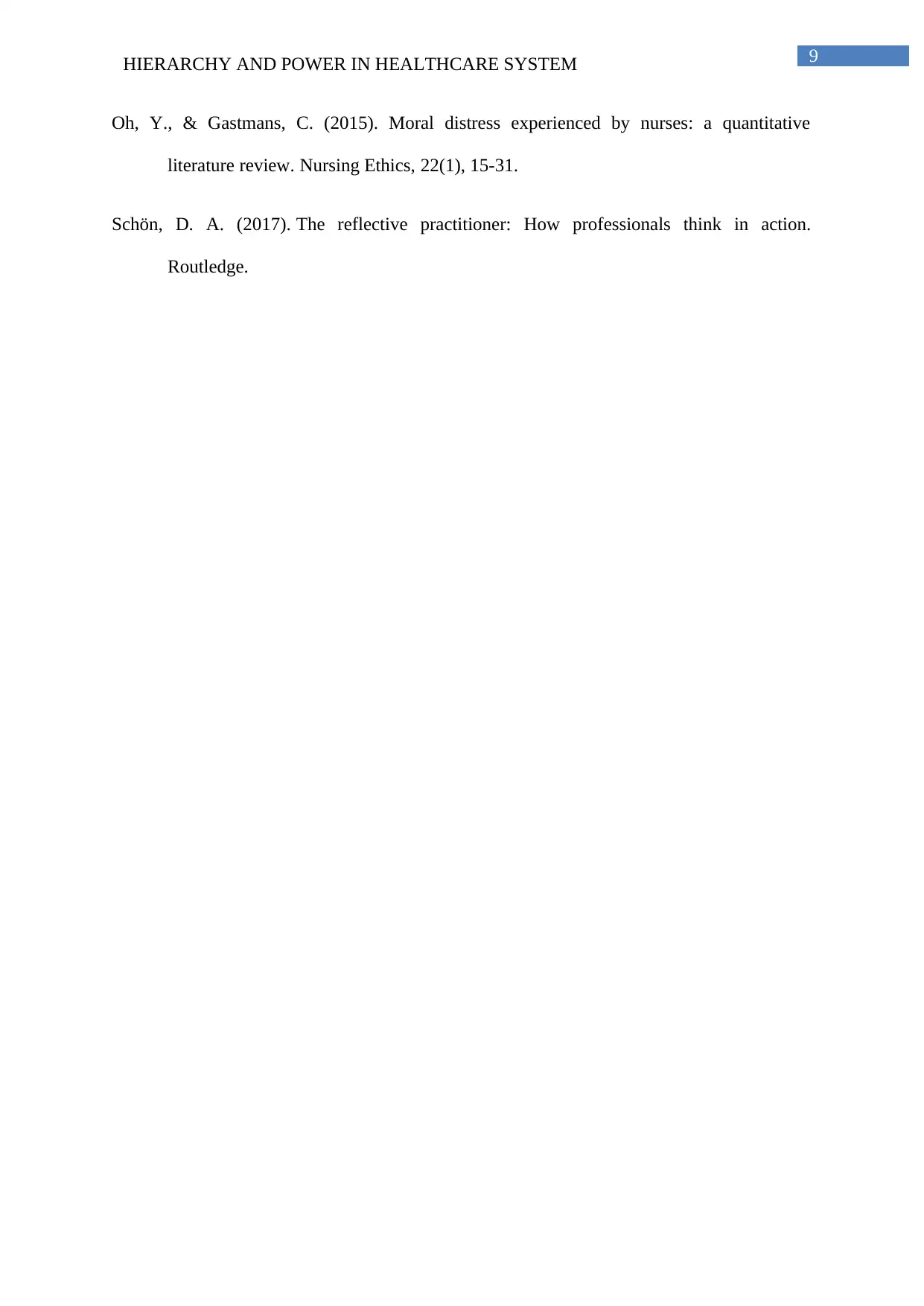
9HIERARCHY AND POWER IN HEALTHCARE SYSTEM
Oh, Y., & Gastmans, C. (2015). Moral distress experienced by nurses: a quantitative
literature review. Nursing Ethics, 22(1), 15-31.
Schön, D. A. (2017). The reflective practitioner: How professionals think in action.
Routledge.
Oh, Y., & Gastmans, C. (2015). Moral distress experienced by nurses: a quantitative
literature review. Nursing Ethics, 22(1), 15-31.
Schön, D. A. (2017). The reflective practitioner: How professionals think in action.
Routledge.
1 out of 10
Related Documents
Your All-in-One AI-Powered Toolkit for Academic Success.
+13062052269
info@desklib.com
Available 24*7 on WhatsApp / Email
![[object Object]](/_next/static/media/star-bottom.7253800d.svg)
Unlock your academic potential
Copyright © 2020–2025 A2Z Services. All Rights Reserved. Developed and managed by ZUCOL.



